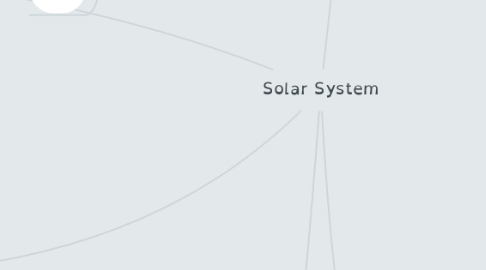
1. Dwarf Planets
1.1. Pluto
1.1.1. Rejected Planet
1.1.2. Orbits on it's side
1.1.3. At parts of it's orbit it gets closer to the sun than Neptune
1.1.4. Pluto is about half the width of the United States
1.1.5. Has an oval shaped path
1.1.6. Temperature on Pluto is about -400 degrees fahrenheit
1.1.7. You'd weigh about 7% of what you weighed on Earth.
1.2. Makemake
1.3. Eris
2. Moon
2.1. Phases of the moon
2.1.1. Full
2.1.1.1. You can see the entire moon
2.1.2. New
2.1.2.1. You see no moon, it is all dark
2.1.3. Quaters
2.1.3.1. With the Quarters you see half of the moon. It is called a quarter because that is how far it is in it's cycle.
2.1.3.1.1. First Quarter
2.1.3.1.2. Third Quarter
2.1.4. Cresents
2.1.4.1. With Crescents you can see just a sliver of the moon.. It is either waxing (getting Bigger) or waning (Getting Smaller)
2.1.4.1.1. Waxing Cresent
2.1.4.1.2. Waining Cresent
2.1.5. Gibbous
2.1.5.1. When you have a Gibbous most of the moon is shoeing with a sliver that is not. It is either waxing (almost to a full moon) or waning (just had a full moon).
2.1.5.1.1. Waxing Gibbous
2.1.5.1.2. Waning Gibbous
2.2. Craters
2.3. Did You Know
2.3.1. There is one side of the moon you never see
2.3.2. The moon does not make it's own light, you see the reflection of the sun
2.3.3. The moon is 4.53 billion years old
3. Asteroids and other flying things
3.1. Asteroids
3.1.1. Large Space rock that orbits the Sun
3.1.2. Most astroids sit in the astroid belt that sits between Mars and Jupitar
3.2. Comets
3.2.1. Comets are mountain sized pieces of dust and ice that orbit the sun
3.3. Meteors
3.3.1. A streak of light that is made of burning meteoroid in Earth's atmosphere
4. Sun
4.1. Center of our Solar System
4.1.1. Has a mass so great it has planets orbiting around it
4.1.2. Most Solar Systems actually have multiple suns, luckily ours doesn't. Could you imagine 2 suns!
4.2. Star
4.2.1. Our sun is just an average sized star. While it may seem huge, there are even bigger stars
4.3. Did you know
4.3.1. The sun is over 27 million degrees Fahrenheit!
4.3.2. Our sun is 4.5 billion years old!
4.3.3. Most stars like the sun burn for about 9-10 billion years old. That means it's half way through it's life😮
5. Galaxies
5.1. Milky Way
6. Planets
6.1. Mercury
6.1.1. Smallest planet in our Solar System
6.1.2. Slightly bigger than our moon
6.1.3. 2nd hottest planet
6.1.4. Rocky Planet
6.1.5. No Atmosphere
6.1.6. No Moons
6.1.7. Spins slowly
6.1.8. Takes 59 earth days for 1 day on Mercury
6.1.9. Smallest Planet in the Solar System
6.1.10. Takes 88 earth days to make up one year
6.1.11. Closest planet to the Sun
6.2. Venus
6.2.1. Hottest Planet
6.2.2. It's gassy surface traps heat making it super toasty.
6.2.3. It's surface is so hot it could melt metal
6.2.4. Just a bit smaller than Earth
6.2.5. One day on Venus is about 243 earth days
6.2.6. One year on Venus is about 225 earth days (yes that mean a year is a little less that a day)
6.2.7. Rotates backwards
6.2.8. Has no moons
6.2.9. 2nd planet from the Sun
6.3. Earth
6.3.1. Water covers over 70% of earths surface
6.3.2. Has many landforms
6.3.3. Atmosphere is mostly nitrogen
6.3.4. Earth is a terrestrial planet
6.3.5. Relatively small compared to other planets
6.3.6. Earth has only one moon
6.3.7. 3rd planet from the sun
6.4. Mars
6.4.1. Cold Desert planet
6.4.2. Half the size of Earth
6.4.3. It gets it's red color from it's rusty iron crust
6.4.4. Very thin atmosphere
6.4.5. Tiny Planet
6.4.6. Rocky
6.4.7. Could have sustained life in the past
6.4.8. A day on mars is about 24.6 hours and a year is about 687 days
6.4.9. Has 2 moons
6.4.10. 4th planet from the sun
6.5. Jupiter
6.5.1. Biggest planet in our Solar System
6.5.2. If it got a little bit bigger it could of become a star
6.5.3. Has big storms, the most famous being the Great Red Spot
6.5.4. Has rings that are too faint to see
6.5.5. Gas Giant
6.5.6. One day on Jupiter is 10 hours
6.5.7. One year on Jupitar is equivalent to 11.8 earth years
6.5.8. 5th planet from the sun
6.5.9. 79 moons
6.6. Saturn
6.6.1. Has the most beautiful rings
6.6.2. Made of Ice and Rock
6.6.3. Gas Giant
6.6.4. Has a very thick atmosphere
6.6.5. Saturn's 7 rings have space between them
6.6.6. A day on Saturn is a bit less than 11 hours
6.6.7. One year on Saturn is 29 earth years
6.6.8. 53 moons (maybe more)
6.6.9. 6th planet
6.7. Uranus
6.7.1. Has a blue Surface because of the methane
6.7.2. Has rings, but are so faint that you can't see them.
6.7.3. Rotates on it's side
6.7.4. Has 27 known moons
6.7.5. One year one Uranus is about 84 years on earth
6.7.6. One day on Uranus lasts about 17 hours
6.7.7. 7th planet from the sun
6.8. Neptune
6.8.1. Has 6 rings
6.8.2. Has a very thick wind atmosphere
6.8.3. One day on Neptune lasts 16 hours
6.8.4. One year on Neptune is about 165 earth years
6.8.5. Has 13 moons
6.8.6. 8th planet from the sun, also the farthest planet
6.8.7. Freezing Cold
6.8.8. 30 times farther from the sun than Earth
6.8.9. Methane gives it it's blue color
